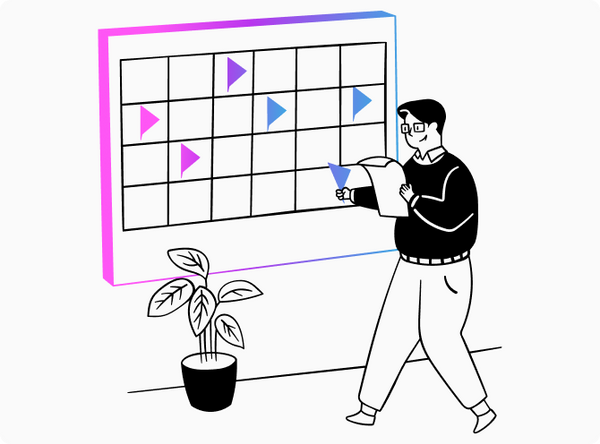
What Comes After You Have Your MVP Ready? Find Out All Steps to Success
 Olexandr Stolniy
Olexandr StolniyWhen it comes to introducing a new product into the market, there is no more important step than creating a Minimum Viable Product (MVP), which is an initial version of a product or service that is released for the purpose of testing and collecting feedback from a target audience.
An MVP can be a great first step for a company in the process of building its own product. However, you still need to market it and reach out to as many of your prospects as possible. In today's blog, we'll discuss what comes after developing an MVP and provide some useful tips to make the MVP marketing process as smooth as possible.
How to Know if Your MVP is Ready for the Next Stage
As a rule of thumb, an MVP is considered to be ready for testing (read marketing) when it has enough functionality for solving the core problem of the audience. In other words, you want to have the main features and design polished out before your MVP is finally presented to the wider public.
All Variations of an MVP that You Should Know
To put any confusion out of the way, let's look at all the options and types of MVPs that developers may come up with. The buzzwords Minimum Marketable Product (MMP), Minimum Marketable Feature (MMF), Minimum Lovable Product (MLP) and Minimum Delightful Product (MDP) might sound like they all mean the same thing, but they don’t.
Minimum Marketable Product (MMP)
Minimum Marketable Product is the minimum version of a product that can be released to the market. It should have enough features and capabilities to be useful and attractive to users, and should be ready for sale with minimal development and testing. The goal of an MMP is to get something to market quickly, without spending too much time or money on development.
Minimum Marketable Feature (MMF)
Minimum Marketable Feature is a single feature of a product that can be released quickly. In fact, an MMF is not a full product, but rather an extension of the existing one — think of an MMP with an enhanced functionality for example. The goal of the MMF is to make the existing product stand out in the market.
Minimum Lovable Product (MLP) / Minimum Delightful Product (MDP)
Minimum Lovable Product (MLP) and Minimum Delightful Product (MDP) are both versions of a product that has all the features and capabilities needed for a customer to love it. The MLPs/MDPs are typically more fully developed than an MMP and take longer to launch. The goal of an MLP/MDP is to create a product that can actually wow or delight potential users, driving brand loyalty and repeat sales.
Ultimately, the key difference between these types is in their degree of development and testing. An MMP is the most basic version of a product that can be released, while an MLP/MDP is the most fully developed and tested product. And an MMF is a feature that carries particular value (for the user). Each of these are used to achieve different goals, depending on the needs of the business and the market.

So What Stages Come After MVP
Developing an MVP is a great way to test your business concept before investing too much time or money into the completed version of the product. However, just because you have a working MVP doesn’t mean your work is done — there are still plenty of things to do. Here are the next steps after creating an MVP that every startup should be taking:
1. Gather customer feedback
Gathering customer feedback is the most important next step after MVP development. It can help to identify potential issues, areas for improvement and possible directions for future updates.
All you need to do during this post MVP step is basically ask users for their opinion on the product and any changes they would like to see. This can be done in a variety of ways, such as surveys, user interviews, focus groups, etc.
2. Think long-term
While it’s important to keep the feedback and suggestions of your users in mind, it’s also necessary to have a plan for where you’d like to take the product in the future. Thinking long-term will help you evolve your MVP into a product that will stand the test of time and remain relevant in the long run.
Consider UI/UX, functionality, and scalability of your MVP. Ask yourself what you want your product to be in 3, 5, or 7 years after the MVP launch. Don't forget to factor in market fluctuations and have some capacity reserved (resource-wise), in case you need to quickly adjust to changing market landscape.
3. Focus on core idea
When developing an MVP, it is easy to get distracted by new features and functionalities. Driven by the desire to introduce as many improvements as possible, startups risk cluttering the interface and structure of their products.
However, it's necessary to stay focused on the core idea — the one that the entire product was built around. If, during the early MVP stages, your concept proved its viability, then it should remain the driving factor behind all development decisions you're about to make.
4. Prioritize your work
In the same fashion as with the core idea of your project, you should allocate resources to those areas first that are directly connected to the value your product provides. You don't want to waste time on tasks that aren’t particularly necessary for the product performance or beneficial to your users. Make sure you improve your core features first and then move to add something extra to your app or website.
5. Listen to your users
We've already talked about the importance of customer feedback, so let's approach this aspect from a bit different perspective. Quite often developers do not actually incorporate user feedback into their product, thinking that they — as those behind the general concept — know better what will work and what won't.
In reality, users can come up with useful insights that may not be obvious to the developers but which can really help improve the project. Thus, not only do we recommend collecting reviews and constructive user criticism, but also that you act on it!
6. Build brand loyalty
As you may have already noticed, the process after an MVP launch is all about engagement with the first adopters of your product. It is important not only because of the feedback you can get from them (for further MVP development) but you get a chance to establish a strong relationship with this group of people and fuel the word-of-mouth marketing. This will help to create a strong foundation for your business as a brand and ease the process of attracting new customers.

8 Reasons Why MVP May Fail
1. No market for the product
Oftentimes, companies launch an MVP thinking that there is a market for their product, only to realize after launching that there is no real demand for it. This is why initial idea validation and market research are essential to the success of any MVP.
Before jumping straight into the development process ask yourself if the product is something that your potential clientele wants. What problem will it help to solve for them? Are there any existing solutions that already target that particular 'need' of your audience? By answering these basic questions you'll be able to better assess market demand and adjust your business strategy.
2. Wrong team
There are several problems that you may encounter when hiring a development team for your project. You could onboard inexperienced programmers who, due to a lack of knowledge, may not be able to carry out MVP implementation.
Another aspect you should keep in mind is that the development team should also have prior experience working in your niche. For example, if you want to develop a healthcare app, look for a healthcare software development company that knows all the ins and outs of this industry. This way you’ll be sure that the project will be delivered to the expectations and requirements set by your market.
3. Got outcompeted
According to CB Insights, getting outcompeted is the third most common reason why many startups fail. Thus, an MVP should be designed to stay competitive in the long-term perspective. It all starts with identifying who your competitors are in the early stages and fine-tuning your MVP after its release to make sure it offers more value to the audience than your competitors do.
4. Poor product delivery
Poor product delivery can cause an MVP to fail quickly. It can be due to a number of things from a cluttered web page layout or inconsistent design across the product to a lack of focus on customer experience, or a lack of testing.
Before the launch, developers need to ensure that the MVP meets all the predefined quality requirements and is bug-free. Even though we're talking about the very first version of your product, it still has to meet user expectations in terms of quality.
5. Weak business model
If you don’t have a solid business model in place, it’s unlikely that your MVP will be able to survive in the long term. Thus, when deciding which model to pick, make sure you stick with the one that is sustainable and profitable for your exact product.
Because even if you come up with a strong offering but weak business strategy, chances are that the next stage after MVP launch could get stalled very quickly. Think of the pricing tactics and the ways users can access your product. It can be anything from going with the fixed price to offering different subscription plans to placing third-party ads into your MVP.
6. Mediocre marketing
Marketing is essential for any product or service, and if not done properly, it can be a major reason for MVP failure. Even if you aren't a marketing expert, try to always focus your promotional efforts on two main things; generating demand and sustaining interest in your product. This will help you better frame your marketing plan and understand how to reach your audience in the most effective way possible.
As to the marketing strategy itself, here you have plenty of options to consider. You can promote your MVP with the help of bloggers, SEO, email marketing, participation in live events, conducting social media surveys, etc. For more about different ways to market your product, read here.
7. Ignoring users
User feedback is the main source of information on what the users want from the product, what features they like, and what needs to be improved. So, by disregarding it, startups risk creating a product that doesn’t meet their customers’ needs or expectations, resulting in low adoption and usage.
When customers see that their opinions are being taken into account, they’re more likely to be engaged with the product and loyal to your brand. This is especially true for early adopters who are likely to be more vocal about their experiences.
8. Running out of resources
During the development of an MVP, it is possible to run out of resources due to a lack of planning or a shortage of funds. This can have a major impact on the success of a project, as a team may be forced to scale back or halt development.
So in order not to run out of resources, be mindful of the limitations that the concept of a "Minimum Viable Product" imposes on the project development. The very first version of your product should include only essential features, be created with minimum investments (relatively speaking), and within a reasonable timeframe (no more than 4 months).
Create Your MVP With Lunka.tech
When looking for an MVP development company, you want to make sure that it has the relevant technical competencies and prior experience working on similar projects. For more than 5 years Lunka.tech has been creating MVPs and full-scale products across a wide range of industries and niches such as telemedicine, e-commerce, HoReCa, healthcare, fintech, and more.
The technology stack that we use includes the most popular programming languages and tools used today for developing digital products of different scales, fields, and uses. We regularly update our portfolio with new projects, so check it out to see how our expertise can benefit your project!

Final Thoughts
Having a successful MVP launch is essential for any business. It’s important to keep in mind though that the development phase itself is only part of the process. After the future release, there's still a lot of work to do to ensure your MVP hits all the projected goals. The right team, adequate business model, and strong marketing strategy can help you significantly reduce risks and optimize development/maintenance costs.
Make sure to follow the aforementioned tips to know which steps after MVP release to take to be better prepared for what comes after MVP product release. For more information on what comes after MVP in Agile or assistance with your project, reach out to our team in any way convenient to you — via phone, email, contact form, or chat section!
FAQ
What stage comes after the MVP launch?
Once your MVP goes live your main job is to make sure it reaches its target audience in the fastest and most effective way possible. You can do that by promoting your MVP via ad campaigns, email marketing, social media surveys, partnering with bloggers, and so on.
Should I outsource MVP development?
It depends on whether you have an in-house team capable of carrying out MVP implementation. If yes, then everything can be done in-house. If not, and you don't want to spend weeks building up a team and then managing everything by yourself, then opting for outsourced software development services would be a more viable option.
How not to fail MVP release?
You want to make sure that your MVP is user-friendly and bug-free. In order for it to become successful it should target the pain points of your users and meet their expectations in terms of design and overall quality.
When should I not build an MVP?
Building an MVP is a great way to validate business ideas or test market assumptions. However, if you are sure that your concept will work — e.g. you may have prior experience building a similar app or website in the same niche — then, you can go with the fully-fledged product right away.


